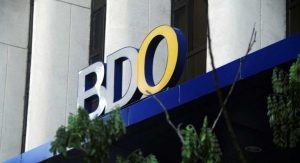BDO UNIBANK, Inc. saw its net income rise by 6.49% in the first quarter on the back of the sustained performance of its core businesses.
Despite a strong start to the year, however, the listed lender expects the central bank’s ongoing easing cycle to hit its margins, although the outlook remains broadly positive, BDO President and Chief Executive Officer Nestor V. Tan said at a briefing following their annual stockholders’ meeting on Friday.
BDO’s net profit climbed to P19.7 billion in the first quarter from P18.5 billion in the same period in 2024, the Sy-led bank said in a disclosure to the stock exchange on Friday. This translated to a return on average common equity of 13.8%.
“Despite economic uncertainties arising from US tariffs and trade policies, the Philippines is expected to remain resilient being a domestic and consumption-based economy. Notably, BDO remains well-positioned to navigate potential risks and achieve sustainable growth and profitability with its strong business franchise, market leadership, and robust capital position,” the bank said.
Net interest income rose by 6% to P47.8 billion in the three months ended March from P44.9 billion driven by growth in its earning assets.
Non-interest earnings increased by 21% year on year to P18.6 billion from P15.4 billion on higher fee-based income.
BDO’s gross customer loans expanded by 11.7% to P3.26 trillion at end-March from P2.92 trillion a year prior as it saw growth across all market segments. Consumer loans grew by 17.3%, middle market loans went up by 12.7%, and corporate loans increased by 8.7%.
The bank’s nonperforming loan (NPL) ratio stood at 1.77%, while NPL coverage was at 143%.
On the funding side, deposits increased by 6% year on year to P3.8 trillion from P3.63 trillion, with its current and savings account or CASA ratio at 70%.
BDO’s assets expanded by 7% to P4.9 trillion as of March from P4.57 trillion a year prior.
Shareholders’ equity increased by 12% to P594.1 million. BDO’s common equity Tier 1 ratio was at 14.4%, up from P13.6% in the same period last year.
Mr. Tan said they expect the Bangko Sentral ng Pilipinas’ (BSP) monetary easing cycle to affect their earnings this year. In 2024, BDO’s net profit increased by 11.73% to a record P82.02 billion.
“When rates are lowered, then of course we get a squeeze on the margin, and that will impact our net interest income… When rates go down, most of our term loans are actually benchmarked against risk-free rates. So therefore, when rates go down, our yields go down,” he said.
“Once spreads are affected, then net income, even though volume is there, will be affected.”
The BSP on April 10 cut benchmark interest rates by 25 basis points (bps) to bring the policy rate to 5.5%, putting its easing cycle back on track after an unexpected pause in February.
The central bank has now slashed borrowing costs by a cumulative 100 bps since it kicked off its rate-cut cycle in August last year.
BSP Governor Eli M. Remolona, Jr. has said that they are considering further reductions this year in “baby steps” or increments of 25 bps. There are four more Monetary Board policy meetings this year, with the next one scheduled for June 19.
Still, the negative impact on its margins could be offset by strong consumer loan growth and lower funding costs, Mr. Tan said.
“On the positive side is improvement in the funding. When reserves were lowered in the latter part of March, it had a positive impact on our funding cost,” he said. “If you have higher growth in consumer [loans], you tend to have higher yields. But the flip-side is you’ll have higher nonperforming loans, losses.”
“When you have more consumer loans, you have a higher delinquency rate. Therefore, it’s natural that your NPLs will go up. The problem, though, is that if banks become reckless, then they are not able to get enough return from the NPLs. Then they will start to have problems. But it’s not a solvency problem. Banks have enough capital. It’s going to be an earnings problem.”
Mr. Tan added that they expect sustained loan and fee income growth, even as global trade uncertainties may affect the corporate segment.
“My view on loan growth is that you have steady demand on the consumer side. But the real drivers will be the middle market and large corporations… We put on hold a lot of capital expenditures during the pandemic and we haven’t seen them normalizing… So, we’re expecting them to normalize. Towards the fourth quarter of 2024, we have seen the pipeline of capital expenditures increasing,” he said.
“In terms of loan growth, this is where we see the impact of the tariff. Large corporates, which are normally the ones that go into huge infrastructure projects and capital expenditures, are now down to high single-digits… They are not abandoning investments, but with the tariffs and with all of the actions happening with Trump 2.0, some of them have opted to defer,” he added.
The bank could also post “slightly elevated” operating expenses as they continue to invest in technology, Mr. Tan said.
“[Our] capital [is] sufficient to support growth. We’re not looking at any potential capital-raising in the near future. We can generate enough to support growth,” he said. “We will need to refinance the maturing obligations that we have, and we will also consider looking at funding on the dollar side of the business should there be some impact of CMEPA (Capital Markets Efficiency Promotion Act).”
The Senate in January passed the CMEPA on third and final reading. The measure aims to boost capital market investments by lowering the stock and documentary stamp taxes and removing preferential the tax rates for passive income.
BDO last tapped the domestic market in July 2024, raising P55.7 billion from its third offering of peso-denominated ASEAN Sustainability Bonds. — A.M.C. Sy
